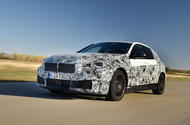New compact hatch ditches rear-wheel drive for front drive. Any car enthusiast or BMW fan worried by that should read on
There’s only one place to start when discussing the new fourth-generation BMW 1 Series: at the front. As opposed to the rear. Because the front is where you’ll find its driven wheels.That’s a fundamental shift. Since the first-generation 1 Series was launched in 2004, it has been rear-wheel drive, a layout long viewed as an essential part of BMW’s ‘ultimate driving machine’ philosophy. Worth talking about, then, right?Except Peter Langen, BMW’s driving dynamic boss, would rather not. “I would like not to discuss with customers whether it’s a front-wheel-drive car or a rear-wheel-drive car,” he says. Instead, he simply wants people to talk about how the new 1 Series is better than the old one, because “every new BMW has to be a better car in terms of drivability”.BMW research suggests the bulk of 1 Series buyers don’t care – or even know – whether the car is front- or rear-wheel drive: they simply want a family hatch with BMW’s blend of premium style and comfort.What those buyers do care about is space – and they want more of it. Because of its rear-drive architecture, the 1 Series simply hasn’t been able to match front-driven rivals such as the Mercedes-Benz A-Class and Audi A3 for space, particularly in the back and boot. Hence the shift to front drive for the new, F40-generation model.The new 1 Series sits on the latest version of BMW’s FAAR front-drive platform, also used for the 2 Series, X1 and X2 SUVs and Mini Countryman. It means that, while roughly the same size as before, the new 1 Series has 30mm more knee room in the rear and an extra 20 litres of boot space, according to BMW.For the majority of potential 1 Series buyers for whom such things matter, BMW believes that could count for more than rear-wheel-drive handling. Of course, plenty of 1 Series owners likely do care about driving dynamics, and we’d suspect Autocar readers make up a disproportionate number of that group. Said group might also be concerned by the fact that the FAAR platform has transverse rather than longitudinal engine mountings.This means that the bonnet is shorter but also that the six-cylinder engine used on today’s range-topping 335bhp M140i won’t fit. Instead, the top model at launch will be a 306bhp M135i xDrive, using a new 2.0-litre four-cylinder engine. As with other higher-level models, the M135i xDrive uses BMW’s all-wheel-drive system, which works the front axle as standard but can send up to half the power to the rear axle.We’ll get back to that model later. But there is cause for concern if chasing a bigger boot has come at the expense of performance. However, Langen would like to reassure you that the new 1 Series still handles like, well, a 1 Series. Only better.“We have technical possibilities more than we had 15 years ago [when the first 1 Series launched] to make a front-wheel-drive car that really is a better BMW,” he says.The firm has spent five years developing systems and hardware to ensure a front-drive 1 Series can match the demands of Langen’s team, particularly working on suspension, differentials and new software.There’s a wider wheel track and an emphasis on increasing body stiffness, including a ‘boomerang’ strut on the rear axle, and mounting bespoke to each of the different F40 models, to ensure they all handle the same.There’s a new mechanical Torsen limited-slip differential and a key area of focus has been on a new traction control system called ARB, which was first seen on the i3S. The system features a controller positioned directly on the engine, reducing signal delay when it detects traction loss. BMW estimates this system can work 10 times faster than a traditional one and, as a result, can more accurately adjust the power delivery as needed. That system also works with BMW’s Dynamic Stability Control (DSC) and yaw control systems, which can apply marginal braking on each wheel to stabilise traction and lateral balance.
Source: Autocar
